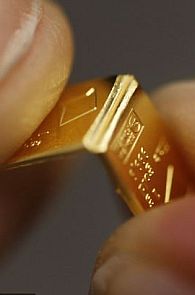India will sell inflation-linked bonds next week - something it tried unsuccessfully more than a decade ago - in the hope that eventually they will catch on enough to help wean millions of Indians off gold, their favoured hedge against rising prices.
 Next Tuesday's auction by the Reserve Bank of India of Rs 1,000 crore (Rs 10 billion) of so-called linkers will be the first in a series, with the government planning to sell up to Rs 15,000 crore (Rs 150 billion) worth in the fiscal year ending in March, 2014.
Next Tuesday's auction by the Reserve Bank of India of Rs 1,000 crore (Rs 10 billion) of so-called linkers will be the first in a series, with the government planning to sell up to Rs 15,000 crore (Rs 150 billion) worth in the fiscal year ending in March, 2014.
The likely buyers are buy-and-hold investors such as insurers seeking long-term investments, and banks looking to include them as part of securities that must be set aside to meet regulatory requirements.
Pricing and liquidity concerns could dull their appeal initially, however.
Investors expect India will offer effective returns between 1.25 per cent to 2 per cent on Tuesday's initial auction of the 10-year inflation-linked bonds, according to a Reuters poll of 10 banks, primary dealers and mutual funds.
That would make returns - the measure investors are using to price the debut debt - lower than equivalent nominal government bonds, which have returned an average of around 2.5 percent over a five-year period.
The expected low returns could dent demand next week from banks and foreign investors. Before building up holdings of linkers, these investors would also need more liquidity than the small size of the auctions can initially provide, as they would want the comfort of being able to exit positions easily.
"It is a good product, but it has to develop a critical mass. Given a lower inflation trend, this is a time when nominal bonds are preferred over real bonds," said Vivek Rajpal, a rates strategist for Nomura in Mumbai.
Ultimately, the government hopes the
linkers will provide some alternative to gold, reducing demand for imports of the precious metal that have helped push India's current account deficit to worryingly high levels.
India is looking at these auctions to professional investors as a way to settle on the right pricing before directly selling them to local households later this year.
The government has indexed both the coupon and interest payments to inflation, making the debt far more appealing than in 1997 when only the principal was linked.
That should make these bonds appealing over the long-term, but only if liquidity is built around the debt instrument.
In emerging Asia, only Thailand and South Korea have issued linkers, but investors are likely to wait and see how the Indian market for the instruments develops before jumping in.
"It's far too new a product from a brand new issuer, so we have no idea on how the market is going to respond," said Kenneth Akintewe, a portfolio manager at Aberdeen Asset Management in Singapore.
"We will let it go for a couple of rounds before looking at it," he added, referring to the upcoming auctions.
India has linked the bonds to the wholesale price index (WPI) with a four-month lag, reducing the appeal of its use as a hedge against inflation as consumer prices remain far higher.
Whereas annual CPI inflation has averaged 10.2 per cent, the WPI has averaged 7.3 per cent over the past fiscal year and last month fell to a three-year low of 4.89 per cent.
The falling WPI has boosted government bonds, sending yields on 10-year debt to near 3-1/2 year lows on hopes the RBI will continue to cut interest rates after already easing by 75 basis points in 2013.
"A floating rate instrument which is illiquid, and can't be hedged is not a good idea for mutual funds who are absolute return players," said Ganti N. Murthy, head of fixed income at Peerless Fund Management Co. Ltd.

 Next Tuesday's auction by the Reserve Bank of India of Rs 1,000 crore (Rs 10 billion) of so-called linkers will be the first in a series, with the government planning to sell up to Rs 15,000 crore (Rs 150 billion) worth in the fiscal year ending in March, 2014.
Next Tuesday's auction by the Reserve Bank of India of Rs 1,000 crore (Rs 10 billion) of so-called linkers will be the first in a series, with the government planning to sell up to Rs 15,000 crore (Rs 150 billion) worth in the fiscal year ending in March, 2014.